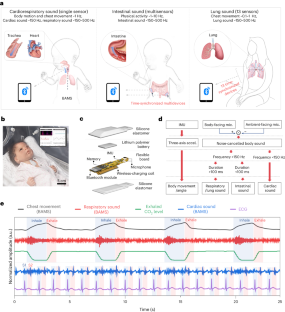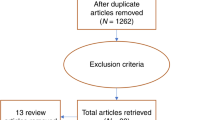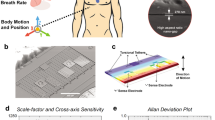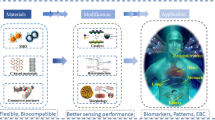Abstract
The human body generates various forms of subtle, broadband acousto-mechanical signals that contain information on cardiorespiratory and gastrointestinal health with potential application for continuous physiological monitoring. Existing device options, ranging from digital stethoscopes to inertial measurement units, offer useful capabilities but have disadvantages such as restricted measurement locations that prevent continuous, longitudinal tracking and that constrain their use to controlled environments. Here we present a wireless, broadband acousto-mechanical sensing network that circumvents these limitations and provides information on processes including slow movements within the body, digestive activity, respiratory sounds and cardiac cycles, all with clinical grade accuracy and independent of artifacts from ambient sounds. This system can also perform spatiotemporal mapping of the dynamics of gastrointestinal processes and airflow into and out of the lungs. To demonstrate the capabilities of this system we used it to monitor constrained respiratory airflow and intestinal motility in neonates in the neonatal intensive care unit (n = 15), and to assess regional lung function in patients undergoing thoracic surgery (n = 55). This broadband acousto-mechanical sensing system holds the potential to help mitigate cardiorespiratory instability and manage disease progression in patients through continuous monitoring of physiological signals, in both the clinical and nonclinical setting.
This is a preview of subscription content, access via your institution
Access options
Access Nature and 54 other Nature Portfolio journals
Get Nature+, our best-value online-access subscription
$29.99 / 30 days
cancel any time
Subscribe to this journal
Receive 12 print issues and online access
$209.00 per year
only $17.42 per issue
Buy this article
- Purchase on Springer Link
- Instant access to full article PDF
Prices may be subject to local taxes which are calculated during checkout






Similar content being viewed by others
Data availability
The data used in the study are not publicly available because they contain information that could compromise research participant privacy. Anonymized data can be made available on request for academic purposes. Sample data of cardiorespiratory signals from a healthy participant are available at https://github.com/JY9292/BAMS_System.
Code availability
The analysis code that supports the findings of this study is available at https://github.com/JY9292/BAMS_System.
References
Virani, S. S. et al. Heart Disease and Stroke Statistics–2020 Update: a report from the American Heart Association. Circulation 141, e139–e596 (2020).
Rajaratnam, J. K. et al. Neonatal, postneonatal, childhood, and under-5 mortality for 187 countries, 1970–2010: a systematic analysis of progress towards Millennium Development Goal 4. Lancet 375, 1988–2008 (2010).
Choi, Y. S. et al. A transient, closed-loop network of wireless, body-integrated devices for autonomous electrotherapy. Science 376, 1006–1012 (2022).
Jeong, H. et al. Differential cardiopulmonary monitoring system for artifact-canceled physiological tracking of athletes, workers, and COVID-19 patients. Sci. Adv. 7, eabg3092 (2021).
Kaszala, K. & Ellenbogen, K. A. Device sensing: sensors and algorithms for pacemakers and implantable cardioverter defibrillators. Circulation 122, 1328–1340 (2010).
Liu, C. et al. Wireless, skin-interfaced devices for pediatric critical care: application to continuous, noninvasive blood pressure monitoring. Adv. Healthc. Mater. 10, e2100383 (2021).
Chung, H. U. et al. Binodal, wireless epidermal electronic systems with in-sensor analytics for neonatal intensive care. Science 363, eaau0780 (2019).
Chung, H. U. et al. Skin-interfaced biosensors for advanced wireless physiological monitoring in neonatal and pediatric intensive-care units. Nat. Med. 26, 418–429 (2020).
Wang, M. et al. A wearable electrochemical biosensor for the monitoring of metabolites and nutrients. Nat. Biomed. Eng. 6, 1225–1235 (2022).
Boriosi, J. P., Zhao, Q., Preston, A. & Hollman, G. A. The utility of the pretracheal stethoscope in detecting ventilatory abnormalities during propofol sedation in children. Paediatr. Anaesth. 29, 604–610 (2019).
Du, X., Allwood, G., Webberley, K. M., Osseiran, A. & Marshall, B. J. Bowel sounds identification and migrating motor complex detection with low-cost piezoelectric acoustic sensing device. Sensors 18, 4240 (2018).
Jahin, S., Moniruzzaman, M., Alvee, F. M., Haque, I. U. & Kalpoma, K. A. A modern approach to AI assistant for heart disease detection by heart sound through created e-Stethoscope. In 2022 25th International Conference on Computer and Information Technology (ICCIT) 669–674 (IEEE, 2022).
Kölle, K., Aftab, M. F., Andersson, L. E., Fougner, A. L. & Stavdahl, Ø. Data driven filtering of bowel sounds using multivariate empirical mode decomposition. Biomed. Eng. Online 18, 28 (2019).
Lee, S. H. et al. Fully portable continuous real-time auscultation with a soft wearable stethoscope designed for automated disease diagnosis. Sci. Adv. 8, eabo5867 (2022).
Pasterkamp, H. The highs and lows of wheezing: a review of the most popular adventitious lung sound. Pediatr. Pulmonol. 53, 243–254 (2018).
Sharma, P., Imtiaz, S. A. & Rodriguez-Villegas, E. Acoustic sensing as a novel wearable approach for cardiac monitoring at the wrist. Sci. Rep. 9, 20079 (2019).
Zhou, L. et al. Acoustic analysis of neonatal breath sounds using digital stethoscope technology. Pediatr. Pulmonol. 55, 624–630 (2020).
Jeong, H. et al. Closed-loop network of skin-interfaced wireless devices for quantifying vocal fatigue and providing user feedback. Proc. Natl Acad. Sci. USA 120, e2219394120 (2023).
Kang, Y. J. et al. Soft skin-interfaced mechano-acoustic sensors for real-time monitoring and patient feedback on respiratory and swallowing biomechanics. NPJ Digit. Med. 5, 147 (2022).
Lee, K. et al. Mechano-acoustic sensing of physiological processes and body motions via a soft wireless device placed at the suprasternal notch. Nat. Biomed. Eng. 4, 148–158 (2020).
Chowdhury, M. E. et al. Real-time smart-digital stethoscope system for heart diseases monitoring. Sensors 19, 2781 (2019).
Islam, M. A., Bandyopadhyaya, I., Bhattacharyya, P. & Saha, G. Multichannel lung sound analysis for asthma detection. Comput. Methods Progr. Biomed. 159, 111–123 (2018).
Rao, A., Ruiz, J., Bao, C. & Roy, S. Tabla: a proof-of-concept auscultatory percussion device for low-cost pneumonia detection. Sensors 18, 2689 (2018).
Shimoda, T. et al. Lung sound analysis helps localize airway inflammation in patients with bronchial asthma. J. Asthma Allergy 10, 99–108 (2017).
Wang, F. et al. A flexible skin-mounted wireless acoustic device for bowel sounds monitoring and evaluation. Sci. China Inf. Sci. 62, 202402 (2019).
Vanden Berghe, J. & Wouters, J. An adaptive noise canceller for hearing aids using two nearby microphones. J. Acoust. Soc. Am. 103, 3621–3626 (1998).
Bland, J. M. & Altman, D. Statistical methods for assessing agreement between two methods of clinical measurement. Lancet 327, 307–310 (1986).
Dipietro, J. A., Caughy, M. O. B., Cusson, R. & Fox, N. A. Cardiorespiratory functioning of preterm infants: stability and risk associations for measures of heart rate variability and oxygen saturation. Dev. Psychobiol. 27, 137–152 (1994).
Hasenstab, K. A., Nawaz, S., Lang, I. M., Shaker, R. & Jadcherla, S. R. Pharyngoesophageal and cardiorespiratory interactions: potential implications for premature infants at risk of clinically significant cardiorespiratory events. Am. J. Physiol. Gastrointest. Liver Physiol. 316, G304–G312 (2019).
Ludington-Hoe, S., Anderson, G. C., Swinth, J., Thompson, C. & Hadeed, A. Randomized controlled trial of kangaroo care: cardiorespiratory and thermal effects on healthy preterm infants. Neonatal Netw. 23, 39–48 (2004).
Wachman, E. M. & Lahav, A. The effects of noise on preterm infants in the NICU. Arch. Dis. Child. Fetal Neonatal Ed. 96, F305–F309 (2011).
Inderjeeth, A.-J., Webberley, K. M., Muir, J. & Marshall, B. J. The potential of computerised analysis of bowel sounds for diagnosis of gastrointestinal conditions: a systematic review. Syst. Rev. 7, 124 (2018).
Tomomasa, T. et al. Gastrointestinal sounds and migrating motor complex in fasted humans. Am. J. Gastroenterol. 94, 374–381 (1999).
Chien, C.-H., Huang, H.-T., Wang, C.-Y. & Chong, F.-C. Two-dimensional static and dynamic display system of bowel sound magnitude map for evaluation of intestinal motility. Biomed. Eng. Appl. Basis Commun. 21, 333–342 (2009).
Li, B., Wang, J.-R. & Ma, Y.-L. Bowel sounds and monitoring gastrointestinal motility in critically ill patients. Clin. Nurse Spec. 26, 29–34 (2012).
Nowak, J. K., Nowak, R., Radzikowski, K., Grulkowski, I. & Walkowiak, J. Automated bowel sound analysis: an overview. Sensors 21, 5294 (2021).
O’Flaherty, N. & Fenelon, L. The stethoscope and healthcare-associated infection: a snake in the grass or innocent bystander? J. Hosp. Infect. 91, 1–7 (2015).
Wright, I., Orr, H. & Porter, C. Stethoscope contamination in the neonatal intensive care unit. J. Hosp. Infect. 29, 65–68 (1995).
Youngster, I., Berkovitch, M., Heyman, E., Lazarovitch, Z. & Goldman, M. The stethoscope as a vector of infectious diseases in the paediatric division. Acta Paediatr. 97, 1253–1255 (2008).
Guilleminault, C. & Pelayo, R. Sleep-disordered breathing in children. Ann. Med. 30, 350–356 (1998).
Pasterkamp, H., Kraman, S. S. & Wodicka, G. R. Respiratory sounds: advances beyond the stethoscope. Am. J. Respir. Crit. Care Med. 156, 974–987 (1997).
Wilkins, R. L. Is the stethoscope on the verge of becoming obsolete? Respir. Care 49, 1488–1489 (2004).
Arts, L., Lim, E. H. T., van de Ven, P. M., Heunks, L. & Tuinman, P. R. The diagnostic accuracy of lung auscultation in adult patients with acute pulmonary pathologies: a meta-analysis. Sci. Rep. 10, 7347 (2020).
Mohanarangam, K., Palagani, Y. & Choi, J. R. Evaluation of specific absorption rate in three-layered tissue model at 13.56 MHz and 40.68 MHz for inductively powered biomedical implants. Appl. Sci. 9, 1125 (2019).
Acknowledgements
This work was supported by the Querrey-Simpson Institute for Bioelectronics at Northwestern University. W.S. is supported by the Pediatric Research Foundation, and both W.S. and G.M.S. were supported by the Montreal Children’s Hospital Foundation (via the Smart Hospital Project) for this project.
Author information
Authors and Affiliations
Contributions
J.-Y.Y., S.O., W.S., W.-Y.M., E.C., G.M.S., D.E.W.-M., A. Bharat and J.A.R. conceived the idea, designed the research and wrote the manuscript. J.-Y.Y., S.O., W.-Y.M., M.-K.C., M.P., S.S., S.Y., G.K. and H.J. designed the device and carried out fabrication. J.-Y.Y. designed operation protocols and the graphical user interface. J.-Y.Y., W.S., E.C., E.J., S.L., A.T. and A. Bharat analyzed data. J.-Y.Y., S.O., W.S., E.C., E.J., M.C., S.L., Y.W., E.O., A. Banks, G.M.S., D.E.W.-M., A. Bharat and J.A.R. carried out experimental validation and analysis. All authors have read and approved the manuscript.
Corresponding authors
Ethics declarations
Competing interests
The authors declare no competing interests.
Peer review
Peer review information
Nature Medicine thanks C. Mascolo, J. Ho, J. DiFiore and S. Niu for their contribution to the peer review of this work. Primary Handling Editor: Michael Basson, in collaboration with the Nature Medicine team.
Additional information
Publisher’s note Springer Nature remains neutral with regard to jurisdictional claims in published maps and institutional affiliations.
Extended data
Extended Data Fig. 1 Design for continuous physiological monitoring system with visual feedback.
A photograph of visual feedback and block diagram illustrating the real-time operational scheme.
Extended Data Fig. 2
Flow chart of two-step adaptive acoustic filtering for separate measurements of body and ambient sounds.
Extended Data Fig. 3 Characterization of sound separation using the BAMS system.
(a, b) Experimental setup using a lung sound trainer, sound meter, with (a) a BAMS system and (b) a commercial digital stethoscope (3 M™ Littmann® CORE, Eko) with active noise cancellation (c) Breath sound and heart sound intensity recorded in an ambient of 90 dB white noise across frequency from 20 to 400 Hz (d, e) Signal-to-noise ratio (SNR) of breath sound and heart sound for the BAMS system and the commercial digital stethoscope, measured in different ambient conditions, including (d) levels of white noise (n = 50 datapoints) and (e) types of sounds with a noise level of 75 dB (n = 50 datapoints). Data are presented as the mean ± standard deviation of SNR.
Extended Data Fig. 4 Cardiopulmonary monitoring and cardio-respiratory coupling analysis during daily activities.
(a) Data corresponding to skin temperature, physical activity, and body sounds captured during daily activities. (b, c) Spectrogram images and intensity of breath and heart sounds as a function of time for recordings collected indoors and outdoors. (d) Respiratory rate, heart rate, heart sound intensity, heart rate variability, and cardio-respiratory coupling extracted from data collected indoors and outdoors. (e) Correlation between heart rate and respiratory rate (n = 4291 datapoints). (f) Cardio-respiratory coupling values as a function of physical activity levels (n = 4291 datapoints). Data are presented as the mean ± standard deviation of cardio-respiratory coupling values.
Extended Data Fig. 5 Continuous long-term cardiorespiratory monitoring during sleep and vigorous activity.
Spectrogram image of cardiorespiratory signal and time series results of activity, respiratory rate, breath sound intensity, heart rate, and cardiac sound intensity.
Extended Data Fig. 6 Monitoring of neonatal cardiac activity using the BAMS system.
(a) ECG signal, spectrogram image, and heart sound intensity. (b) Bland-Altman plots comparing heart rate determined using the BAMS system with ECG measurements (5 neonates, 136,013 data points).
Extended Data Fig. 7 Monitoring of neonatal respiratory behavior using the BAMS system, nasal thermistor, and respiratory inductance plethysmograms.
Spectrogram images and time series results comparing respiratory behaviors obtained from breath sounds measured with the microphone in a BAMS system, temperature measured with a nasal thermistor, chest wall movement measured with the IMU in a BAMS system, and the summation of respiratory inductance plethysmograms measured with chest and abdomen RIP bands.
Extended Data Fig. 8 Respiratory rate data collected in the NICU and comparisons to standard measurements.
Bland-Altman plots comparing respiratory rate determined using the BAMS system with nasal temperature flow measurements (5 neonates, 42,738 data points).
Extended Data Fig. 9 Effects of ambient noise on measurements of respiratory sounds.
(a) Microphone data and spectrogram image of respiratory sounds with and without 70 dB white noise. (b) Frequency distribution of respiratory sounds determined by FFT of recorded data. (c) Spectrogram image and respiratory sound intensity with bandpass filtering from 150 Hz to 300 Hz, and (d) spectrogram image and respiratory sound intensity with sound separation.
Supplementary information
Supplementary Information
Supplementary Figs. 1–32 and Tables 1 and 2.
Supplementary Video 1
Audio reconstructions of body sound data with and without sound separation.
Rights and permissions
Springer Nature or its licensor (e.g. a society or other partner) holds exclusive rights to this article under a publishing agreement with the author(s) or other rightsholder(s); author self-archiving of the accepted manuscript version of this article is solely governed by the terms of such publishing agreement and applicable law.
About this article
Cite this article
Yoo, JY., Oh, S., Shalish, W. et al. Wireless broadband acousto-mechanical sensing system for continuous physiological monitoring. Nat Med 29, 3137–3148 (2023). https://doi.org/10.1038/s41591-023-02637-5
Received:
Accepted:
Published:
Issue Date:
DOI: https://doi.org/10.1038/s41591-023-02637-5
This article is cited by
-
Wireless multisite sensing systems for continuous physiological monitoring
Science China Materials (2024)



